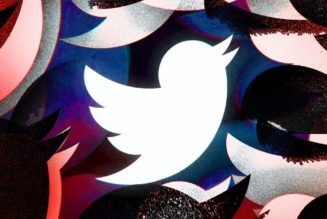
I.
Last week, a partnerships manager at Medium working with the White House found that there was a strange problem with the platform: President Joe Biden was being served porn.
The manager was in a video conference with a White House staffer to discuss how Biden, who had used Medium as a campaign blog in 2020, could begin posting to the official Medium @POTUS account. While sharing his screen with the White House, the staffer logged in to @POTUS and saw the first article recommended to him by Medium: “A is for After,” which a sub-headline described as “a cuckold love story.”
It’s unclear if the White House saw the story. But after the meeting, the Medium staffer tried to improve Biden’s recommendations. He followed political topics; he “read” posts by President Obama and Vice President Kamala Harris while logged in as the president. When he refreshed his recommendations, Medium recommended another piece of erotica: “Getting a Piece (and Some Pizza Too),” a story that carries the sub-headline “step sister taboo erotica.”
The employee previously found that Medium had somehow added Biden as a writer on 10 “garbage publications,” as well as at least one software development blog. “President Joe Biden is Being Served Erotica on Medium.com,” the staffer complained in an internal post.
The episode captured Medium in all its complexity: a publishing platform used by the most powerful people in the world; an experiment in mixing highbrow and lowbrow in hopes a sustainable business would emerge; and a devotion to algorithmic recommendations over editorial curation that routinely caused the company confusion and embarrassment.
On Tuesday, it also cost dozens of journalists their jobs. In a blog post, billionaire Medium founder Ev Williams announced the latest pivot for the nearly nine-year old company. Just over two years into an effort to create a subscription-based bundle of publications committed to high-quality original journalism — and in the immediate aftermath of a bruising labor battle that had seen its workers fall one vote short of forming a union — Williams offered buyouts to all of its roughly 75 editorial employees.
“We have published many stellar stories that found a wide audience and more than paid for themselves,” Williams wrote. “But our hit rate has been low, and we’re not near where we need to be to make it work economically.”
Medium entered the year with more than 700,000 paid subscriptions, putting it on track for more than $35 million in revenue, according to two people familiar with the matter. That’s a healthy sum for a media company. But it represents a weak outcome for Williams, who previously sold Blogger to Google and co-founded Twitter, which eventually went public and today has a market capitalization of more than $50 billion.
Medium has raised $132 million in venture capital, but its last funding came in 2016. Williams has been funding the company out of his own pocket since then, sources said.
To Williams, colleagues say, Medium is first and foremost a technology product. From the start, he has looked for ways to use journalists to bring cachet to a platform anyone can publish to. But the underlying platform has grown to include writing of every kind: viral posts about COVID-19; generic business wisdom; tech blogging; productivity porn; actual porn. Jeff Bezos used Medium to talk about the time he got blackmailed.
Medium’s original journalism was meant to give shape and prestige to an essentially random collection of writing, gated behind a soft paywall that costs readers $5 a month or $50 a year. Eleven owned publications covered food, design, business, politics, and other subjects.
But in the end, frustrated that Medium staff journalists’ stories weren’t converting more free readers to paid ones, Williams moved to wind down the experiment — throwing dozens of journalists’ livelihoods into question, just as he had in 2015, when he laid off 50 people amid a pivot away from advertising on the site. (This 2019 history of the company by Laura Hazard Owen in Nieman Lab offers a definitive look at the company’s stop-start relationship with journalism up to that point.)
“We remain fully committed to high-quality editorial and to the open platform model that supports independent writers,” Medium told me in a statement. “The voluntary buyout reflects changes we’re making to our editorial team to create a more flexible organization that focuses on both. We see a real opportunity within our editorial operation to continue developing our model and to elevate the value we provide to our readers and writers.”
But interviews with 14 current and former Medium employees over the past day paint a portrait of a dysfunctional company built to celebrate writing only to become famous for its poor treatment of writers.
And not only writers: In recent weeks, Medium’s chief operating officer and vice president of engineering left the company. Several other engineers are leaving or planning to. Williams is now the company’s CEO, de facto COO, and since last year, its head of product.
II.
So what happened?
Like most such efforts, Medium’s renewed push into original journalism in 2018 was greeted with optimism by the reporters and editors who were hired to build the project out. One editor recounted to me the joy at being told they could pay freelancers $1 a word — more than they had been able to pay at previous jobs.
The company launched publications including OneZero, for tech; Elemental, for health; and Zora, for Black and brown women. Over the next two years, much of its fresh, insightful journalism would be acclaimed by an industry beleaguered by layoffs. At OneZero, Matt Stroud revealed that the CEO of a tech company backed by SoftBank had once been a neo-Nazi, leading to the CEO’s departure from the company; “The Zora Canon,” a list of the best books written by African American women, earned coverage everywhere from NPR to the New York Public Library.
The push into original reporting was rewarded with strong growth in paid subscriptions, current and former staffers said. But journalism was rarely at the center of the company’s marketing efforts. Employees expressed frustration that the company did so little to promote their work, hampering efforts to grow their publications’ brands — particularly during the crucial early months in which readers were forming impressions of them. Publications often had only skeletal branding or visual design; some “launched” before their editors-in-chief had even been hired. (On the other hand, I’m told, Medium’s public relations team exclusively promoted owned and operated publications, as did its social media accounts.)
With millions of dollars sunk into the effort, Medium’s push into journalism represented a significant investment. But individual publications often got little attention — and what resources they did get began shrinking within months. It was too much, and too little, all at once. “We were set up to fail,” a former employee told me.
This was particularly true for publications that, like Zora and its sister publication Level, sought to break Medium out of its Silicon Valley bubble and reach more diverse audiences. Most of the company’s readers look like Williams: 71 percent are white, 55 percent are male, and 53 percent make more than $100,000 a year, according to internal numbers shared with me. Employees had pushed for improved diversity, equity and inclusion in the workplace at least since 2018, when a white former executive repeatedly rapped the N-word during a performance of the Notorious B.I.G.’s “Big Poppa” during a company karaoke outing. The matter was investigated, and the executive eventually apologized and stayed on.
Staffers believed it would take both significant promotion and time to reach audiences outside Medium’s mostly white Silicon Valley core. But in the end they would receive neither.
Last year — barely 12 months into the experiment — Williams had already grown uncomfortable with the cost of the team he had just built. Paid subscriptions, which had been on the rise, flatlined in 2020. Publication budgets were cut — and then cut again, and again. Editors who were lured to Medium on the promise of being able to build out full-fledged publications were suddenly begging for enough money to pay for a handful of freelance stories a week.
The rest of their “publications” would comprise posts written on spec by an army of self-serve freelancers who uploaded their work to the platform in hopes it would be selected by an editor for promotion. This program, called “Amplify,” has become a core pillar of Williams’ vision for the future. Instead of paying full-time salaries and benefits to staff, Williams can use Amplify to get the content he wants at a fraction of the cost.
Amplify’s writers are paid a small and essentially random fraction of subscription revenue, based on how many people read their story. In theory their financial upside is unlimited, but in practice the program pays almost no one a living wage. A venture capitalist bragged to me that he had made $25,000 on Amplify over the past 11 months — a great sum for a side hustle, but barely enough to make the rent for most writers. Certainly it could not compete with the advances offered by the upstart newsletter platform Substack, which captivated the media’s attention last year as a series of staff writers for large publications, myself included, left their jobs to write newsletters on the platform. (See my ethics disclosure about Substack.)
Opinions vary on how threatened Williams feels by Substack, but managers often bragged about Medium’s superiority as a place to work, employees said. “Internally it has always been messaged as, ‘we’re better than Substack, we have more integrity, we’re more up front about our business model,’” one current staffer told me.
Still, Medium had an answer to Substack in a program codenamed Hopscotch. Medium would pay advances to high-profile writers including the New Yorker’s Susan Orlean and antitrust crusader Tim Wu to encourage them to post regularly on the platform. As with its journalism, Medium did not market the program’s existence or the writing of the participants, and it’s unclear whether Williams considers it a success. Advances paid Medium appeared to be significantly smaller than Substack offered; one source told me Orlean was paid $25,000 to write occasionally on the platform, compared to the $250,000 that Substack gave Matt Yglesias and a small number of other high-profile writers.
Williams’ investment in Amplify and Hopscotch reflected a growing interest in what he calls “relational media” — one-on-one relationships between readers and writers, mediated by the platform. In his view, relational media poses a challenge to traditional, publication-based journalism — a reason he would ultimately give for offering buyouts to his reporters. “The role of publications — in the world, not just on Medium — has decreased in the modern era,” Williams wrote.
But Williams had other reasons for his declining interest in staff-led publications. Last year, aware of their sites’ budget cuts and fearful for a repeat of Medium’s 2015 layoffs, members began organizing. Williams took the initiative personally, colleagues said, and believed that a union would make the company less nimble and effective as it worked to become sustainable.
Worse, the data suggested that Medium’s original journalism was not converting free readers to paid subscribers. Surprisingly, what seemed to convert readers most reliably were random stories on the digital content farm that had sprung up around its high-gloss publications.
People were largely not finding these stories from journalists or even from Medium’s own recommendation algorithms, which staffers said were ineffective in predictably driving traffic. Instead, like most publications in the platform era, Medium’s traffic successes came from search engines and social networks.
“Hits would be made either because we managed to get a prime spot on Google or because something made it big on Facebook,” a former employee who worked on the tech platform told me.
The original idea behind Medium going all the way back to 2012 was that professionally written stories would create a “halo” around the much larger body of user-generated content, enough to give the entire site a premium feel — and eventually, one that Williams could charge a subscription fee for. But by the end of 2020, the journalism didn’t feel like a halo — it felt like an albatross. And so the journalists were offered buyouts. (And generous ones, by the standards of American journalism: five months of severance pay, and six months of healthcare.)
But to many of the journalists, the news came as a surprise. Employees had gotten mixed messages about which metrics they should use to evaluate their own performance. Traffic? Paid conversions? Something else? Often they were told not to think about any of it. Just do your jobs, they were told, and everything will be fine.
“They believed if you write it, they will come,” one employee told me. “And it never worked that way.”
Medium is far from the only company to tell its journalists to ignore the traffic generated by their stories while managers monitor it obsessively in the background. But it created an environment in which reporters were confused about how they, or their publications, would ultimately be judged — leaving them vulnerable to being blindsided when the end finally came.
III.
Ultimately, employees said, responsibility for the events of the past year belonged to Williams, the company’s 48-year-old CEO and one of the few constants at the company since its founding.
Few startups have an easy path to success, and media in particular is a notoriously difficult business. Just today, digital culture publication MEL laid off its entire staff. Some staffers told me they appreciated the opportunity Williams had given them during a turbulent time, and said he had granted them impressive creative freedom and significant financial resources with which to do their journalism.
Staffers who worked on Medium’s core technology platform generally had less positive things to say. Williams was prone to change his mind often, seemingly on a whim, they said, making software development difficult. The product roadmap over the years looks like a series of blind alleys: in 2019, a take on Snapchat stories; last June, a refreshed newsletter platform; in January, an acquisition of an e-book publisher.
In his blog post, Williams said he “can see more focused, high-affinity publications working well as part of the Medium bundle.” But staffers I spoke with at Medium’s existing publications largely do not expect them to survive, at least in their current form. A skeleton crew of editors will likely be kept on to promote user-generated posts to the relevant sites; what once had been publications are now likely better thought of as topic pages.
Meanwhile, the company will continue to rely on Google and Facebook traffic to generate hits it can convert into paid subscribers. The acquisition of the e-book publisher, Glose, is intended to create a bigger library of “evergreen” content on Medium that will drive more traffic to the site via search engines. Like Blogger and Twitter before it, Medium will bet on unpaid labor and algorithms.
All of which might be fine to the dozens of journalists about to lose their jobs, if Williams would publicly claim some responsibility for his part in the chaos — ”this crazy ride,” as he called it yesterday. Instead, he points to changes in the industry and shrugs. The media business — what can you do?
But of the employees who remain, few are buying it.
“He keeps talking like this company founded in 2012 is a brand new startup finding its way,” one told me. “At a certain point you’re not nimble and iterating. You’re just floundering and failing to follow through and execute.”
This column was co-published with Platformer, a daily newsletter about Big Tech and democracy.










